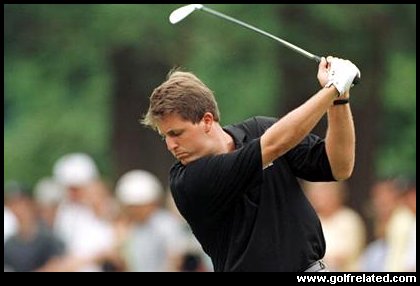The amount of physics involved in tee-ing off
is amazing. The impact between the ball and club lasts for only about
450 millionths of a second, but the results of this impact can be incredible.
For example, Tiger Woods can get the ball moving with an initial velocity
of about 180 miles per hour. The process of driving the ball involves all
three of Newton's laws, as well as conservation of both mass and energy.
Initially the ball is sitting at rest on the tee. It does not move
because no net force is being exerted on it. This is an application of
Newton's first law, which states that an object with no net force acting
on it will move with a constant velocity, which in this case is zero meters
per second. As a golfer starts the swing, chemical energy from the golfer's
body is being converted to mechanical energy which goes into the club. As
the club head makes impact with the golf ball several physics applications
are involved. First of all the ball is no longer at rest because the club
is exerting a force on it. Based on Newton's second law we know that force
is equal to mass multiplied by acceleration. The harder the club is swung
the greater the force exerted on the ball will be. Since mass is constant
we can then conclude that the harder the swing, the faster the ball will
accelerate. Newton's third law also comes into play upon impact. The law
states that for every action force there is an equal and opposite
reaction force. When the club head exerts a force on the ball, the ball
exerts the same size force in the opposite direction on the club. The force
of the club accelerates the ball, and the force of the ball slows down the
club. Because the club is more massive than the ball, the effects of this
reaction force is not nearly so noticeable as the force the club exerts on
the ball. The collision between club and ball is approximately elastic,
meaning that both energy and momentum will be conserved. Part of the energy
and momentum are transferred to the golf ball, causing it to sail dow fairway.
The rest is still associated with the club, causing the golfer to follow
through after the collision.
Main Page
Physics of the Golf Ball
Physics of the Clubs
In-Flight
The Short Game
Bibliography

